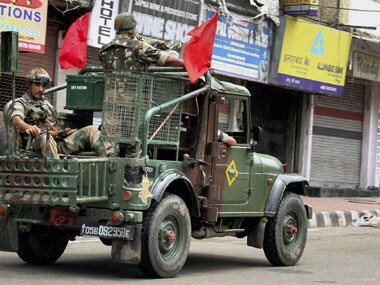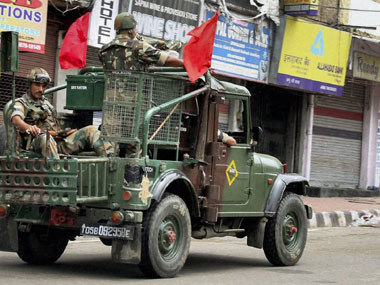By Wajahat Qazi The sordid saga of riots - both potential and real - has reared its ugly head in Jammu and Kashmir. Sectarian rumblings preceded by killings in Gool, Ramban, and now rioting of a communal nature in Kishtwar, bode ill for a state known for pluralism, and multicultural coexistence. While the immediate cause and catalyst for these incidents may be political and attempts to draw political mileage from these may be the premise, it stands to reason that a sober appraisal and review must be carried out. The reason is to arrive at insights that may help to quell and pre-empt this kind of violence in future. [caption id=“attachment_1029773” align=“alignleft” width=“380”]  Army personnel patrol a street during curfew in Jammu. PTI[/caption] It may, in the final analysis, be the salience of group identities that comes to the fore during times of stress and tension that culminates in riots. This assertion warrants elaboration. The exegesis carried out in this article is not premised on original thinking but is more or less a paraphrasing of the seminal work of psychoanalyst Sudhir Kakar. Titled, The Colours of Violence, Kakar’s lucid tract dwells on the nature, causes and typologies of riots. Kakar’s insights are merely reproduced here in an attempt to utilise these in the service of peace and amity. The reproduction of Kakar’s work, given the constraints of space, is selective; not comprehensive or exhaustive. The starting point of Kakar’s analysis is the nature of group identity. According to Kakar, “group identity is an extended part of individual self experience, although the intensity of this experience varies across individuals and with time. It can range from feelings of nominal affiliation with the group to a deep identification or even feelings of fusion, where any perceived harm to the group’s interests or threats to its ‘honour’ are reacted to as strongly as damage to one’s own self”(Kakar, 1995:ix). Despite the spread of individualism and personal autonomy, we may still be a tribal people in different permutations and combinations. This tribal nature and heightened feeling of the group comes to the fore during periods of stress and tension. Individual identity gets collapsed and folds or melts into the wider communal identity. Stereotyping ensues and groups increasingly see each other as communities corresponding to these stereotypes. “When group salience becomes high, an individual thinks and behaves in conformity with the stereotypical characteristics of the category ‘Hindu’ (or ‘Muslim’) rather than according to his or her individual personality dispositions. In a period of rising social tension, social identity dominates, if it does not altogether replace, personal identity as individuals perceive members of the ‘Other’ group purely in terms of the former. As Hindus and Muslims increasingly see each other as stereotypes, there follows an inevitable homogenisation and depersonalisation. Individual Hindus or Muslims become interchangeable, perceiving each other in terms of shared category characteristics rather than their personal, idiosyncratic natures.” (Kakar, 1995:53). Even minor differences between ‘us’ and ‘them’ are exaggerated as unbridgeable chasms in what Freud called the ‘narcissism of small differences’ which evoke stronger hostility and hate than do wide disparities.” (Kakar,1995: 54-55). Stereotyping leads to the dehumanisation of the ‘Other’ and is the prelude to violence. “The stereotyping of the enemy group involves a progressive devaluation which can extend to the point of dehumanisation where ‘they’ come close to the child’s earliest non-human targets of externalisation. Making the enemy non-human is to avoid feeling guilty about destroying ‘it’ in the riot that is imminent.” (Kakar,1995:55). Once the group feeling is aroused and stereotypes kick in, a dynamic ensues wherein ‘the madness of the crowds’ sets in. Catalytic events and mass psychosis ensues where the collective or communal identity of the group crowds out other identities which lead to raw passion wherein fears and hopes get mixed. “Besides the ultimate cause , a riot has a period of immediate tension and a precipitating incident. The precipitating incident is immediately followed by the aggrieved group taking out a procession - when the procession itself is not the incident.” (Kakar, 1995:56). “As personal identity disappears in a crowd , the self-experience of the cultural group identity is evoked more and differently by shared cultural symbols and history - heavily mythologised- which is shaped by the group’s hopes and fears and distorted by its ambitions and ideals”(Kakar, 1995:57). “Identity in a crowd gets refocused. This refocusing is certainly dramatic and full of effect since a crowd amplifies all emotions, heightening a feeling of well being into exaltation and fear into panic. This loss of personal identity in a crowd, however, makes individuals act in terms of the crowd’s identity. The individual is not operating at some regressed, primitive level of the psyche but according to the norms of the particular group.” (Kakar, 1995:58) This ties into the self, the nature of the self and religion. In certain states, religiously inspired experience can lead to self transcendence and a calm state and peace but in others it can lead to a psychic and psychological orientation that is destructive. “In an integrated state, religious self-hood is a quiet self experience marked by calmness of the spirit that comes from being alone in the presence of the numinous. However, in a state of fragmentation or threatened disintegration, religious selfhood is prey to a variety of dysphoric moods.” (Kakar, 1995:245). “A threat to the community aspect of religious identity gives birth to communalism, intolerance and the potential for social violence. In the communal phase, the feelings of intimacy and connectedness characterising the religious community are polluted by an ambience of aggression and persecution. The change from community to communalism is accompanied and, indeed, initiated, by a heightened awareness of the We-ness , making the community aspect of religious identity hyperconscious.”(Kakar, 1995: 246). This state leads to the formation of group boundaries, their delimitation and exclusion of the ‘Other’ or the perceived enemy. “Communalism as a state of mind, then, is the individual’s assertion of being part of a religious community, preceded by a full awareness of belonging to such a community. This inevitably leads to intolerance of all of those outside the boundaries of the group.” (Kakar, 1995:246). “However, at this stage , the violence that inheres in this can only range from a mild contempt to obsessive fantasies around the extermination of the enemy ‘Other’ rather than find explosive release in arson, rioting and murder. The psychological ground for violence has, however, now been prepared.” (Ibid). However, it is more, or still, latent. “For the outbreak of violence, the communal identity has to swamp personal identity in a large number of people, reviving the feelings of love connected with early identifications with one’s own group members and hate towards the out-group whose members are homogenised, depersonalised and increasingly dehumanized”.(Kakar,1995:247). What then feeds and leads to actual violence? A psychological threshold needs to be crossed for actual violence to occur. “For social violence to occur, the threat to communal identity has to cross a certain threshold where the persecutory potential becomes fully activated and persecutory anxiety courses unimpeded through and between members of a religious group.” Kakar, 1995:247). “Amplified by rumours, stoked by religious demagogues, the persecutory anxiety signals annihilation of a group identity and must be combated by its forceful assertion. Acting demonstratively in terms of this identity as a Hindu or Muslim though threatens members of a rival community who too mobilise their religious identity as a defense. The spiral of threats and reactive counter threats further fuels persecutory anxiety and only the slightest of sparks is needed for a violent explosion.” (Ibid). What are the implications and lessons that can be drawn from this anatomy of a riot for Jammu and Kashmir? Jammu and Kashmir is a multicultural mosaic where people of different faiths, cultures and different ethnic groups constitute its firmament. Whilst this diversity is a condition that is laudable and should be cherished, it contains within it the potential for conflict. The nature and form that this conflict can take may correspond to the dynamics of group identity. It is against the collapsing of the multicultural mosaic of the state into its constituent faiths and ethnicities that eternal vigilance has to be taken recourse to. This can be done by ensuring and promoting equitable economic development and the deeper inculcations of tolerance and forbearance amongst the people of the state. In short, there has to exist multiculturalism of both word and deed and both the state and society should be on the same page regarding this. Jammu and Kashmir, despite the latest flareup, is defined by values of tolerance, amity and interfaith harmony. The recent events constitute an aberration. However, there is, like in every society, latent conflict potential, especially because of the diversity that defines the state. The narrative that should be privileged in the state is that of the values of harmony, pluralism and tolerance. This should be overlain by an ethno-nationalism that is not exclusive. It is under these rubrics that the ‘We’ feeling will be broadbased and inclusive and not split into its constituent units. This is the need of the hour and all energy should be devoted to reclaiming and intensifying the plural and multicultural ethos of the state.
Psychoanalyst Sudhir’s Kakar’s insights on communal violence are useful to understand the recent communal violence in Jammu & Kashmir.
Advertisement
End of Article
Written by FP Archives
see more


)

)
)
)
)
)
)
)
)



